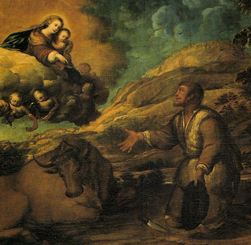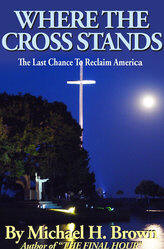The year was 1326. The location was southwest of Madrid. The event was an apparition of the Virgin Mary at a spot — near the Guadalupe River in Spain — that quickly was turned into a shrine, two full centuries before the far more famous Guadalupe appearances in Mexico (which were probably named for this earlier Spanish appearance of Mary).

He prayed at the shrine before all voyages and a replica of Mary as represented at the site (a Black Madonna) traveled with him to the new world (on the Santa Maria).
Is this why modern secularists resist Columbus? Do they sense his deep spirituality?
For deep — far deeper than even most Catholics know — it was.
“[Queen] Isabella had prayed at the foot of the Black Madonna for guidance on whether to finance Columbus’s journey,” notes an historical account. “Columbus went to the monastery to pray for a safe voyage. When he returned to Spain, he traveled to the monastery [at Guadalupe] to thank the Virgin for her help and protection.”
This gets to the nitty-gritty of it and also takes us to what is not recorded in history textbooks.
For Christopher Columbus was not only a devout Catholic, but — like other explorers who would follow in his wake — a missionary. He considered the evangelization of the New World his primary goal.

One such island he named Guadeloupe. Others were christened with names such as San Salvador (for the Savior).
In fact, Columbus, one comes to learn, was a third-order Franciscan who when possible attended daily Mass, including a liturgy as well as Confession before setting out on his dangerous, remarkable, history-making exploration. Don’t tell public schools this! (Not even Catholic schools know it.)
Fair of complexion, with freckles and an aquiline nose, neither pudgy nor rail-thin, with grey hair, on the muscular side, high of cheekbone, somewhat taller than average, with the carriage of an aristocrat, yet the sensibilities of a crewman, Columbus often wore a monk’s cord around his waist and sometimes — not aboard, that anyone has reported, but after his famous expeditions — was seen in a monk’s robe, entertaining thoughts, at one point, of entering a monastery.
This was one very Catholic man, which goes a ways toward explaining the attempts by secularists to downplay his critical role (in the modern establishment of two continents) to the point of eliminating a day that on the American calendar dedicated to him.
Amazingly enough, Columbus’s goal was not just discovery of new territories, as one writer noted, but “bringing the remote and unknown regions of the earth into communion with Christian Europe; carrying the light of the true Faith into benighted and pagan lands and gathering their countless nations under the holy dominion of the Church.”
This is hidden history. This we never learn in history class.

On the Santa Maria, the standard of the Cross was raised, and the explorer carried a picture of Jesus Crucified. Some believe they sang “Star of the Sea” on the way across the often foreboding Atlantic — these waters so prone to tropical storms, even category-five ones.
Concerned about direction, and anxious to spot land, Columbus and his crew at one point spotted a strange light that to this day has not been explained definitively. This was on October 11, 1492, and was described, in his own journal, as “a small wax candle that rose and lifted up, which to few seemed to be an indication of land.”
Academics have come up with various potential explanations: that it was tar torches carried by natives, or the bioluminescence of protozoa along the rock (this latter explanation discarded due to Columbus’s depiction of it as from a point source, and also the timing: such protozoa only radiate lights after a full moon; this was near the first quarter). Whatever it was, the worried crew soon caught sight of land.
Upon landing, Columbus immediately planted the standard of the Cross and prostrated himself three times in thanksgiving, according to biographer George Barton, kissing with teary eyes “the soil to which he was conducted by the Divine Goodness,” while the others “participating in his emotions and kneeling as he did, elevated a Crucifix in the air.
“Raising his grateful hands and thanking from the bottom of his heart his Heavenly Father, Columbus found in the effusions of his loving gratitude, an admirable prayer, the first accents of which are preserved by history: ‘Lord Eternal and Almighty God, Who by Thy Sacred Word hast created the heavens, the earth, and the seas, may Thy Name be blessed and glorified forever. May Thy Majesty be exalted who hast deigned to permit that, by Thy humble servant, Thy Sacred Name should be made part of the world.'”
Christopher Columbus was declaring half of the world — a hemisphere stretching, as it turned out, more than twenty thousand miles, from Chile to Alaska, from Vancouver to Puerto Rico — for Christianity; for Catholicism; for Jesus.
No wonder later scholars would later seek to besmirch him!
No wonder his name is being eradicated from the public square!
How many secularists — atheists — would want it known that the discovery of America was an intensely Christian moment, and more specifically, a Catholic one?
[adapted from Where the Cross Stands]
Today’s secularists certainly slander and hate Christopher Columbus, but they truly hate the Virgin Mary more.
The conversion of millions of Aztecs from their human sacrificing to the one true faith, was a response to those souls lost resulting Martin Luther’s apostasy.
(Columbus was also seeking a new route the India to avoid the danger of Mohammedan pirates who were capturing slaves.)
Milwaukee just renamed “Christopher Columbus” park to “Indigenous People’s” park. I fly the flag of Queen Isabella and King Ferdinand from my house every Columbus Day.
Yours in Christ,
Bob Dwyer]



